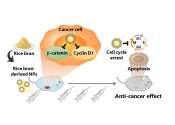Bran is the hard outer layer of grain and consists of combined aleurone and pericarp. Along with germ, it is an integral part of whole grains, and is often produced as a by-product of milling in the production of refined grains. When bran is removed from grains, the grains lose a portion of their nutritional value. Bran is present in and may be milled from any cereal grain, including rice, corn (maize), wheat, oats, barley and millet. Bran should not be confused with chaff, which is coarser scaly material surrounding the grain, but not forming part of the grain itself.
Bran is particularly rich in dietary fiber and essential fatty acids and contains significant quantities of starch, protein, vitamins and dietary minerals.
Rice bran is a byproduct of the rice milling process (the conversion of brown rice to white rice), and it contains various antioxidants that impart beneficial effects on human health. A major rice bran fraction contains 12%-13% oil and highly unsaponifiable components (4.3%).[citation needed] This fraction contains tocotrienols (a form of vitamin E), gamma-oryzanol and beta-sitosterol; all these constituents may contribute to the lowering of the plasma levels of the various parameters of the lipid profile. Rice bran also contains a high level of dietary fibres (beta-glucan, pectin and gum). In addition, it also contains ferulic acid, which is also a component of the structure of nonlignified cell walls. However, some research suggests there are levels of inorganic arsenic (a toxin and carcinogen) present in rice bran. One study found the levels to be 20% higher than in drinking water. Other types of bran (derived from wheat, oat or barley) contain less arsenic than rice bran, and are just as nutrient rich.
The high oil content of bran makes it subject to rancidification, one of the reasons that it is often separated from the grain before storage or further processing. The bran itself can be heat-treated to increase its longevity.







